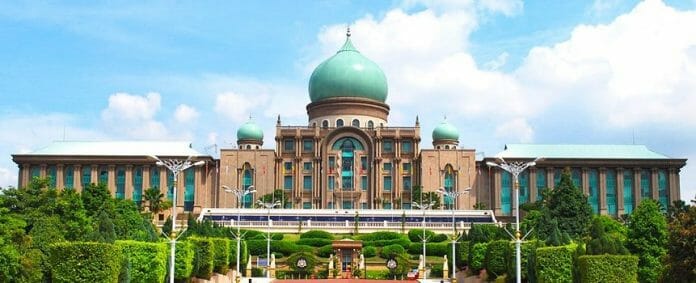By Jason Loh,
Strengthening and promoting institutional resilience is key to ensuring national resilience especially as the nation continuously adapt to the new normal and prepare ourselves for a post-Covid-19 world. Institutional resilience here can be simply defined as the capacity and capability of the whole of government to quickly adapt to exigencies and disruptions, and sustain the transformation process across the spectrum: public healthcare, disaster management, federal-state cooperation, fiscal effectiveness, public delivery system, etc.
Institutional resilience relates to the management of the decision-making processes under conditions of stress and shocks as well as to quickly adopt new ways of doing things.
The government – past and present – have demonstrated political will and policy intention to ensure that our institutions continue to improve on their resilience. We see this in two key areas, namely “digitalisation” and “improvisation”.
The government must not be complacent but continue to move forward the institutional and policy reconfigurations, especially during the current 5th and forthcoming 6th national recovery phases of “Rejuvenate” and “Reform”, respectively.
Firstly, the government needs to continue the drive towards digital transformation.
The Unit for the Implementation and Coordination of National Agencies on the Economic Stimulus Package (Laksana) formed by the Ministry of Finance (MOF) is, of course, one of the recent pre-eminent examples of this. As it is, Laksana monitors the implementation of the initiatives rolled out under all the economic stimulus packages so far, namely the Economic Stimulus Package (ESP), Prihatin 1.0, Prihatin SME Plus, Penjana and Kita Prihatin as well as Budget 2021 via a digital dashboard that connects 53 ministries and agencies in a centralised and real-time database. Hence, Laksana allows and enables the government to have an instant bird’s eye view of the picture that will mitigate against the time-lag effect in implementation, as a common problem.
Other examples can be readily seen in the initiatives under the purview of the Malaysian Administrative Modernisation and Management Planning Unit (Mampu). It is the leading government agency tasked with monitoring the implementation of the exercise to digitalise the delivery of services in the public sector.
According to Mampu, by the end of 2020, the government plans to make 40 percent of its public services “end-to-end” as well as to create four service clusters. “End-to-end” means the entire process in the delivery of government services – from start to finish, without physical intermediaries.
This is best embodied by the MyGovernment Portal (Government Online Services Gateway) launched in 2017 to function as a “single gateway to all government online services” revolving around the life-cycle needs of citizens. Other policy initiatives include the Digital Government Transformation Action Plan (2017-2018).
As such, a digital government not only drives a more inclusive and integrated delivery service. In the event of a crisis such as the on-going Covid-19 outbreak or even worse, this low-touch and physically fragmented delivery of government services will ensure their effective seamless continuity – thus mitigating against any possible or potential breakdown and the need for a temporary interruption or suspension.
In this regard also, our Critical National Information Infrastructure (CNII) – created under the National Cyber Security Policy (NCSP) and managed by the National Cyber Security Agency (Nacsa) – plays a vital role in managing the portal by which cyber security issues can be exchanged.
At the same time, a digital government also needs to be more data-driven.
Under the Public Sector ICT Strategic Plan (2016-2020), the Public Sector Open Data initiative was introduced through the development and implementation of the government online platform – data.gov.my. This strengthens and promotes government-citizen ties that in turn feeds into the “whole of society” loop or processes on the back of digitalisation.
Popularly, the democratisation and de-centralisation of data is best captured in blockchain or distributed ledger technology (DLT).
Blockchain is now catching up in government circles and processes with the introduction of the TradeLens platform by the Royal Malaysian Customs Department (RMCD) recently that will in turn boost the use of the e-country of origin (COO) system of traceability, among others.
This use of blockchain will not only improve the overall role and function of the RMCD but also ease and facilitate import-export transactions of the private sector stakeholders (shipping/logistics, traders). Specifically, the TradeLens platform – as jointly developed by AP Moller-Maersk with IBM and based on the Collaboration Application Programming Interface (API) concept – ensures that all logistic activities such as haulage, warehousing, shipping and freight forwarding at both domestic and international levels can now be wholly integrated.
In short, digitalisation ensures that government and society as a whole is much better prepared and positioned to adapt to the challenges and disruptions brought about by externalities as well as internally-induced factors.
Secondly, we need to continue improvising because it means adaptability, agility and flexibility – to meet the exigences of the time, including unexpected or “black swan” situations. To be able to improvise, therefore, is to break out of groupthink and rigid adherence to pre-existing policy goals and trajectories, and not least old ways of doing things.
This means government institutions must be always ready for a “joined-up” approach operating under a multi-ministerial task force, for example.
In fact, we have some semblance already with senior ministers in charge of the respective clusters set against the backdrop of the Covid-19 crisis. Of course, we are emulating Singapore’s example in this regard – with its senior ministers also acting simultaneously as coordinating ministers.
Our ministries, departments and agencies alongside statutory bodies as well as even leading government-linked investment companies (GLICs) and government-linked companies (GLCs) should be able to coordinate and integrate their efforts towards a single policy goal which to be sure will still comprise of several sub-policy objectives.
A good example would be in the context of a macro-economic strategy that is mission-oriented towards job creation as the “point of concentration and convergence”.
Thus, defeating Covid-19 and recovering entails a multi-ministerial effort whereby each institution plays its role accordingly with the view of achieving a bigger objective such as the above.
At another level, it takes more than institutional reorganising to ensure sustainability of the improvisation, however. We need to not only go further by perhaps merging ministries or creating relevant portfolios to be added to existing ministries.
But also ensure closer and greater coordination and integration of policy mandates and functions such as between fiscal and monetary policies under MOF (Treasury) and Bank Negara, respectively, particularly given the unprecedented times we are in. Critically, coordination between fiscal and monetary policies will help to ensure and promote the sustainability of our national debt.
Lastly but not least, the concept of Total Defence (Pertahanan Menyeluruh or Hanruh) as conceptualised and outline under the Defence White Paper (DWP 2019) should be enhanced further – to harness and deploy all the resources of the nation in a more systematic and cohesive fashion.
Other existing strategic frameworks on the one hand and institutions on the other are also the building-blocks by which institutional resilience can be improved upon. Examples of the former are the National Biotechnology Policy (2005-2020), National Water Resources Policy, National Digital Network Initiative (Jendela), etc. The latter would be the National Security Council (NSC), the National Disaster Management Agency (Nadma), and the Crisis Preparedness and Response Centre (CPRC) under the Ministry of Health (MOH).
In conclusion, we have done well so far in terms of institutional resilience.
Perhaps the most current and relatable example would be exemplified in our response to the Covid-19 crisis, notwithstanding the emergence of a later third wave that has seen spikes in infections, mainly due to cluster cases involving foreign workers and prisoners, and the “infiltration” of undocumented migrants as in the case of Sabah.
But we need to do more and also to prepare the groundwork so that when another crisis strikes, it will propel us to rise above the occasion.
Jason Loh Seong Wei is Head of Social, Law & Human Rights at EMIR Research, an independent think tank focussed on strategic policy recommendations based on rigorous research.









